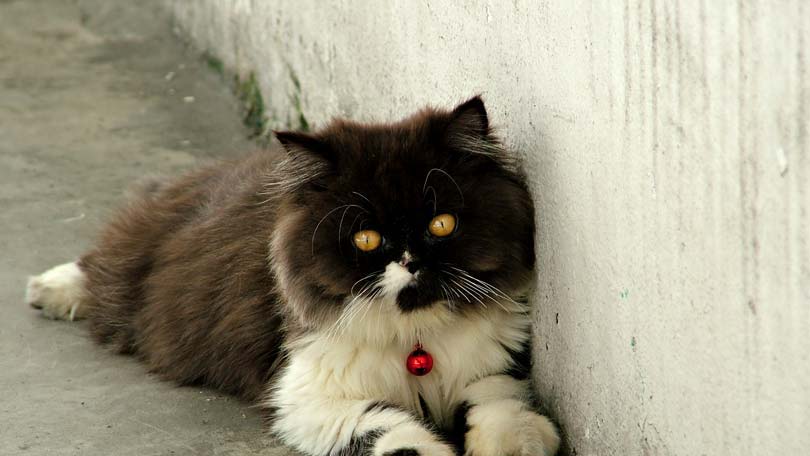
My husband loves Christmas. He loves Christmas almost to the point of pathology. One of my friends described the extent of our holiday decorations most aptly one December with the phrase, “Wow, it looks like Santa Claus exploded in here.”
The deepest part of my husband’s affections is focused on his Christmas village. Made of porcelain with little lights that twinkle at night, each small building is nestled into a mound of foam batting that serves as snow. There are little people and little trees that go along with the buildings, completing an entire utopian Christmas subculture resting on top of our piano.
One Christmas, I was awakened by a sound during the wee hours of the morning. It was not, in fact, the feet of eight tiny reindeer on the roof, but was instead the sounds of Maddie, our oldest cat, retching somewhere in the house. I jumped out of bed with the intention of locating the pile before stepping into it sometime later in the day. I arrived in the living room just in time to see Maddie produce a river of projectile vomit as she squatted in the center of Christmas Village. It ran down Main Street and washed away a tree and a pedestrian before coming to rest at the foot of the stairs of the church. Poor Maddie, flanked by the porcelain school and the toy shop seemed to sigh, a look of nauseated relief on her face.
Fortunately, the snow was replaceable and the pedestrian washable, but I often wonder if my husband will mourn my passing as much as he did the soiling of Christmas Village.
Most people who have shared their homes with cats have witnessed more than their share of vomiting. Most of the time, these are isolated incidents that cause no more stress for pet and owner than the amount of distress caused by stepping in the pile with one’s bare feet. Multiple episodes of vomiting can, however be a symptom of much more serious underlying illnesses in cats and should be taken seriously. The key steps in a rapid recovery are a thorough history, a complete physical examination by your veterinarian, some routine tests and standard treatment protocols.
There are a few signs you should look for in trying to determined whether or not your cat’s vomiting is a cause of significant concern. Is your cat still acting completely normal, aside from the vomiting episode? Or has his or her energy levels changed, either increasing or decreasing from what you know to be normal for your pet? Is there blood in the vomit, or which should always be a cause of concern, or is there enough hair in the vomit to make up another pet for your family? If your cat has stopped eating, you should contact your veterinarian as soon as possible. Finally, think about what is normal for your cat. If he or she has always vomited every Sunday and suddenly adds Wednesdays into their vomiting repertoire, you should consult your veterinarian, even if your cat looks as though the experience has not caused any long term trauma. As always, if in doubt, err on the safe side and consult your veterinarian.
A veterinarian’s approach to a vomiting cat is pretty standard. The first step is to get an accurate history of your pet’s symptoms. Has there been any diarrhea along with the vomiting? How often is your cat vomiting, and what signs are they showing before and after they vomit? Could they have gotten into anything, like string, or have you given them a new type of food or treat? Are your pet’s vaccines up to date, and are they going outside at all? Have you noticed any other signs, such as weight loss or changes in appetite? An accurate picture of what you see going on at home is the first step to a diagnosis.
Your veterinarian will also do a though physical examination on your cat. During this examination, they will be assessing your pet’s general condition, including checking for a fever. They will check in your cat’s mouth for signs of a string trapped around your cat’s tongue. Your veterinarian will be able to determine how dehydrated your cat has become, if at all, from the vomiting episodes. They will also feel you cat’s abdomen for signs of a foreign object trapped in the intestines as well as for abnormalities in the size of the organs in the abdomen, such as the kidneys or liver.
Based on the physical examination, your veterinarian will likely recommend some testing to help diagnose your cat’s cause of vomiting. These could include blood work, radiographs of your cat’s abdomen, or an ultrasound. Blood work can be used to evaluate kidney and liver function, electrolyte balances, which can be altered by vomiting, signs of dehydration, anemia or infection. Radiographs may be taken, with or without a dye in the intestines, given to make obstructions more obvious. X-rays can show foreign objects in the intestines, changes in the sizes of internal organs, or show tumors or changes in the thickness of the intestines. Ultrasound can give these changes even more detail, aiding in your veterinarian being able to reach an accurate diagnosis.
Ultimately, it may be necessary for your veterinarian to do an exploratory surgery to directly examine and biopsy your pet’s intestinal tract. This usually entails a general anesthetic and short hospital stay. While the surgery may pose a small amount of risk to your pet, it may be the fastest and most accurate way to reach a diagnosis. It also may be necessary to remove foreign objects that are lodged in the intestinal tract.
Treatment for vomiting in your cat can include a number of interventions. The most important portion of the treatment protocol is to remove the underlying cause, whether that is eating a poisonous plant or Monopoly pieces, an organ failing, or some type of allergic bowel disease. While doing this, your vet will likely also correct any dehydration that is present with sterile electrolyte solutions, given either into a vein or under the skin. Antibiotics may be given to treat any bacterial infection, while anti-nauseants may be given to calm the intestinal tract and stomach. Your vet could also give pain medications to make your pet more comfortable while recovering.
In summary, when your cat has been leaving his or her stomach contents on your bedspread as a gift to you, the keys to a rapid recovery are a thorough history, a complete physical exam by a veterinarian, a standard set of tests and treatment. These may be done with you cat as a hospitalized patient or as an outpatient, depending on the severity of the illness. Vomiting is not a disease in and of itself, but a symptom of many possible underlying issues. The earlier you are able to intervene along with your veterinarian, the less likely you will be to have your own Christmas Village tragedy.





